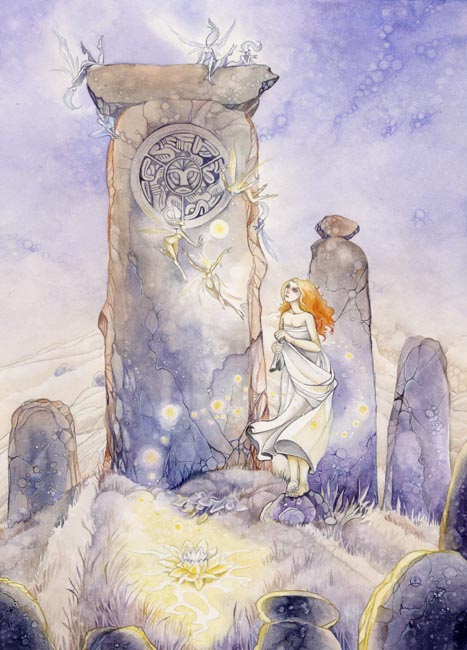
by Stephanie Pui-Mun Law
SHR Main Page | Opera Propria | Pax Hermetica Introduction
 |
by Stephanie Pui-Mun Law |
Stonehenge, the tribunal that covers the mortal Kingdom of England and the Principality of Wales, has changed beyond measure since the Mythic Age.
The covenants of Stonehenge were sheltered from the initial ravages of the Dark Days. House Tremere were weak in the tribunal, and there was little to bring the Scientists and their cannons from the more powerful Latin kingdoms. With the advent of the brief period of religious persecutions brought on by the spread of Protestantism, more people than the Protestants found themselves being persecuted. Only rapid spells cast in haste saved many a Hermetic magus, and some were less fortunate. This then was the situation by 1558, when Elizabeth I came to the throne.
The Order was in some debate about what to do, the majority, indeed, favouring the Quaesitorial line that the whole thing would blow over and was unlikely to occur again. However, a young Jerbiton Magus named Dr John Dee changed all that. Despite flagrantly breaching the Code ("I shall not meddle in the affairs of the mundanes"), he set himself up as Court Wizard to Elizabeth I. The Quaesitores did nothing. He pressed at the tribunal for a move of the magis' activities away from the traditionally remote areas to the infinitely more influential heartlands of the south-east of England. The tribunal thought it over; the plan had some merits, although the vis supply in that area was considerably poorer than elsewhere and the auras notoriously erratic. Dee did not wait on the debate but instead set about acquiring lands within the City of London once occupied by the Templars and still known as "The Temple." He succeeded with surprisingly little objection from the lawyers, who were the other main inhabitants of that small area of London. He then invited his sodales to join him at the "Covenant of the Temple." He pointed out that the aura, while varying considerably within the small area he had obtained, was more than strong enough to be a viable base for magi, while vis could be transported in by grogs or apprentices. The political power was in London, and from this all else would flow. Astonishingly, a reasonable number of magi took him up on his offer. The Quaesitores, inexplicably, still did nothing.
Time passed, and more and more power was sucked into the Temple to the extent where it became impossible to administer as a single covenant. A second covenant was founded in London in 1601; "The Eternal Struggle" was inhabited by a mixture of Flambeau and Tytalus magi, and their well-meaning interference in the political scene in London did nothing to defuse the political situation that would lead to the English Civil War. A third covenant came to London from the Loch Leglean Tribunal in 1602, after the accession of James VI of Scotland to the English throne. "The Black Flame" was (and remains) the largest truly mystical covenant in the tribunal to this day, consisting almost entirely of members of Houses Ex Miscellanea, Criamon and Bonisagus. As a counterbalance to this massing of mystics in London, a covenant of Quaesitores and their attendant Hoplites was established within the Temple, now the collective term for this powerful hub of covenants. "The Blind Lady," as this covenant was called, rapidly became a power in the land, enforcing itself more vigorously than did even its predecessors, who despite their aberrant treatment of Dee had been as strict as the Code dictated.
Since that time, the Covenant of the "True Temple," the original founding covenant, has slipped quietly but assuredly into Winter, with its last member dying in the Summer of 1998. In that time, however, more and more of the magical power of the tribunal has concentrated in London. Supervision of the outlying areas of the country has become patchy at best, and dark rumours are beginning to spread of bad influences in such covenants as do remain isolated from the Temple. For the last five years there has been an increasing fashion for the establishment of new covenants in these areas, in an attempt to reinforce the (weakened) Pax Hermetica.
The following represents a partial list of other covenants in the Stonehenge tribunal.
The itinerant covenant of Semitae continues to wander the Stonehenge tribunal, along its incomprehensible path. It is still led by a magus or maga known as Gerfallon (or perhaps, "the Gerfallon"), a member of House Criamon who is the only one who knows what path it will follow or why it does so...
Located in the mountains of Wales, the covenant of Llyn-Dhu occupies a bubble of air magically maintained at the bottom of a lake. Meanwhile, other enchantments ensure that the waters of the lake itself remain largely opaque, preserving the covenant from casual mundane observation. The covenant is home to five Hermetic witches and is the unofficial headquarters of the organisation of Hermetic witches known as the Grove, hosting periodic meetings during which the group's rituals are enacted.
The covenant of Stonehenge occupies a magical regio deep within the famous stone circle on Salisbury Plain. Here Hermetic seekers attempt to plumb the circle's secrets, largely undisturbed apart from the odd (usually intoxicated) individual who accidentally crosses into the regio during the revels of the Summer Solstice. Indeed, this has become such a frequent occurrence that one magus and a group of grogs maintain watch for any such individuals during the revels, ensuring that the revellers in question are returned to the mundane world with no memory of their supernatural experience!
Text copyright © Tom McKinnell and Niall Christie 2006.
Artwork copyright © Stephanie Pui-Mun Law 2006.